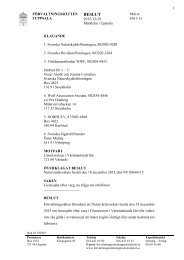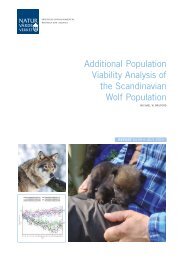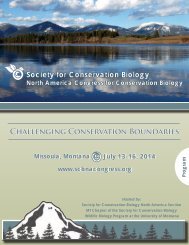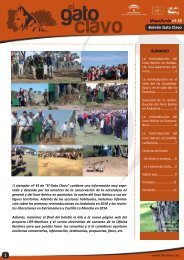1oC3Dbk
1oC3Dbk
1oC3Dbk
Create successful ePaper yourself
Turn your PDF publications into a flip-book with our unique Google optimized e-Paper software.
Medicinal Plant Specialist Group<br />
The mission of the Medicinal Plant Specialist Group is to<br />
increase global awareness of threats to the survival of<br />
medicinal plant species, and to promote sustainable use and<br />
conservation action.<br />
In 2013, members of the group contributed to pursue<br />
several on-going and new IUCN Red List assessment<br />
initiatives; including regional assessments of European<br />
medicinal plants (funded by the European Union), and national<br />
assessments of medicinal plants in Lebanon (with funding from<br />
the United Nations Development Programme) and India (in<br />
collaboration with the Institute of Trans-Disciplinary Health<br />
Sciences and Technology). We enlarged our Global Checklist<br />
of Medicinal Plants to include nearly 30,000 taxa, and used it<br />
to define a priority list of 1,500 species for global assessments<br />
under a new IUCN Plants for People project partially funded by<br />
the MAVA Foundation.<br />
Group members also provided risk analyses of wildharvested<br />
plant species and populations for private sector<br />
companies as a service to the FairWild Foundation to support<br />
implementation of the FairWild Standard for sustainable wild<br />
collection. Members of the group continued to serve as<br />
founding members of the FairWild Foundation’s Board of<br />
Trustees and as members of the Foundation’s technical,<br />
license, and communications committees. Much of this work<br />
has been undertaken in collaboration with the TRAFFIC<br />
Medicinal and aromatic plants trade programme.<br />
The risk analysis methodology developed by MPSG<br />
members has been included as one of nine steps in new<br />
guidance for Parties to CITES, undertaking non-detriment<br />
findings for perennial plants listed on Appendix II. Version 1.0<br />
of this guidance, produced through a TRAFFIC/WWF Germany<br />
project funded by the German Federal Agency for Nature<br />
Conservation (BfN), published in 2014.<br />
Danna J. Leaman<br />
Chair, Medicinal Plant Specialist Group<br />
Mediterranean Plant Specialist Group<br />
2013 has been a very special year for our Specialist Group as<br />
its extent of occurrence expanded from the Mediterranean<br />
Islands (we were the Mediterranean Islands Plant Specialist<br />
Group) to the whole Mediterranean area. This is quite a large<br />
quantitative jump, with a very large number of taxa: 25,000<br />
species, half of them being endemics to the area. We now<br />
have 55 members, representing 21 countries. We are about to<br />
Etlingera elatior (Jack) R.M.Sm. © D.J. Leaman<br />
Ebenus cretica from Crete, Greece. © Bertrand de Montmollin<br />
form a new thematic and geographic sub-group, The<br />
Moroccan Plant and Livelihoods Sub-Group, with about 20<br />
members, with the aim of developing species conservation in<br />
Morocco, together with supporting community development<br />
initiatives. A new and independent Red List Authority for the<br />
Mediterranean Plants was created and chaired by Errol Vela,<br />
based in Montpellier, France. It will validate IUCN Red List<br />
assessments carried out in the Mediterranean, and as this<br />
number increases, this will be a real challenge.<br />
In 2013, we prepared, together with Plantlife and the<br />
IUCN’s Centre for Mediterranean Cooperation, a project called<br />
“Conserving wild plants and habitats for people in the south<br />
and east Mediterranean”. This project, submitted to the MAVA<br />
Foundation for funding, will strengthen the significance of<br />
Important Plant Areas as tools for biodiversity conservation<br />
involving plant species and habitats; directly contributing to<br />
regional and national decision-making. Our members were<br />
also involved in the programme “Ensuring the survival of<br />
Endangered plants in the Mediterranean Islands” (also funded<br />
by MAVA) and we plan to prepare, together with the existing<br />
team managed by Kew Gardens, a second phase for this<br />
project.<br />
In our strategy, we plan to prepare the ‘TOP 100<br />
Mediterranean Plants’, continuing our work with ‘The Top 50<br />
Mediterranean Island Plants’, and to contribute to the<br />
implementation of IUCN Knowledge Products, specifically The<br />
IUCN Red List and hopefully The Red List of Ecosystems. We<br />
are also excited to be associated with the defining criteria of a<br />
‘Key Biodiversity Area’; we believe this will drive significant<br />
support for plant conservation, as Important Plant Areas did.<br />
We are very concerned by the difficulties faced by our<br />
members and colleagues in several South and East<br />
Mediterranean countries, and hope that it will soon be easier<br />
for them to work in the field.<br />
Bertrand de Montmollin<br />
Chair, Mediterranean Plant Specialist Group<br />
Specialist Groups, Task Forces and Red List Authorities<br />
69






